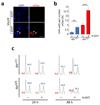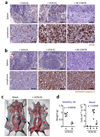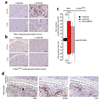Exploiting oncogene-induced replicative stress for the selective killing of Myc-driven tumors
- PMID: 22120667
- PMCID: PMC4894468
- DOI: 10.1038/nsmb.2189
Exploiting oncogene-induced replicative stress for the selective killing of Myc-driven tumors
Abstract
Oncogene-induced replicative stress activates an Atr- and Chk1-dependent response, which has been proposed to be widespread in tumors. We explored whether the presence of replicative stress could be exploited for the selective elimination of cancer cells. To this end, we evaluated the impact of targeting the replicative stress-response on cancer development. In mice (Mus musculus), the reduced levels of Atr found on a mouse model of the Atr-Seckel syndrome completely prevented the development of Myc-induced lymphomas or pancreatic tumors, both of which showed abundant levels of replicative stress. Moreover, Chk1 inhibitors were highly effective in killing Myc-driven lymphomas. By contrast, pancreatic adenocarcinomas initiated by K-Ras(G12V) showed no detectable evidence of replicative stress and were nonresponsive to this therapy. Besides its impact on cancer, Myc overexpression aggravated the phenotypes of Atr-Seckel mice, revealing that oncogenes can modulate the severity of replicative stress-associated diseases.
Figures





Comment in
-
Thresholds of replication stress signaling in cancer development and treatment.Nat Struct Mol Biol. 2012 Jan 5;19(1):5-7. doi: 10.1038/nsmb.2220. Nat Struct Mol Biol. 2012. PMID: 22218289 No abstract available.
References
-
- de Bono JS, Ashworth A. Translating cancer research into targeted therapeutics. Nature. 2010;467:543–549. - PubMed
-
- Bryant HE, et al. Specific killing of BRCA2-deficient tumours with inhibitors of poly(ADP-ribose) polymerase. Nature. 2005;434:913–917. - PubMed
-
- Farmer H, et al. Targeting the DNA repair defect in BRCA mutant cells as a therapeutic strategy. Nature. 2005;434:917–921. - PubMed
Publication types
MeSH terms
Substances
Grants and funding
LinkOut - more resources
Full Text Sources
Other Literature Sources
Miscellaneous

